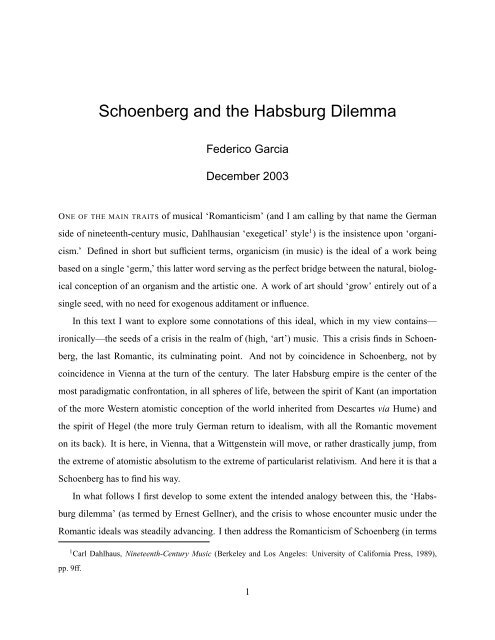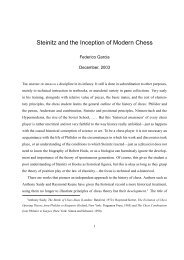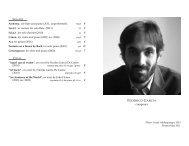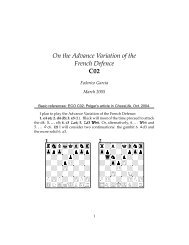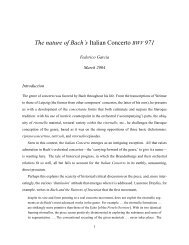Schoenberg and the Habsburg Dilemma - Federico Garcia
Schoenberg and the Habsburg Dilemma - Federico Garcia
Schoenberg and the Habsburg Dilemma - Federico Garcia
Create successful ePaper yourself
Turn your PDF publications into a flip-book with our unique Google optimized e-Paper software.
<strong>Schoenberg</strong> <strong>and</strong> <strong>the</strong> <strong>Habsburg</strong> <strong>Dilemma</strong><br />
<strong>Federico</strong> <strong>Garcia</strong><br />
December 2003<br />
ONE OF THE MAIN TRAITS of musical ‘Romanticism’ (<strong>and</strong> I am calling by that name <strong>the</strong> German<br />
side of nineteenth-century music, Dahlhausian ‘exegetical’ style 1 ) is <strong>the</strong> insistence upon ‘organicism.’<br />
Defined in short but sufficient terms, organicism (in music) is <strong>the</strong> ideal of a work being<br />
based on a single ‘germ,’ this latter word serving as <strong>the</strong> perfect bridge between <strong>the</strong> natural, biological<br />
conception of an organism <strong>and</strong> <strong>the</strong> artistic one. A work of art should ‘grow’ entirely out of a<br />
single seed, with no need for exogenous additament or influence.<br />
In this text I want to explore some connotations of this ideal, which in my view contains—<br />
ironically—<strong>the</strong> seeds of a crisis in <strong>the</strong> realm of (high, ‘art’) music. This a crisis finds in <strong>Schoenberg</strong>,<br />
<strong>the</strong> last Romantic, its culminating point. And not by coincidence in <strong>Schoenberg</strong>, not by<br />
coincidence in Vienna at <strong>the</strong> turn of <strong>the</strong> century. The later <strong>Habsburg</strong> empire is <strong>the</strong> center of <strong>the</strong><br />
most paradigmatic confrontation, in all spheres of life, between <strong>the</strong> spirit of Kant (an importation<br />
of <strong>the</strong> more Western atomistic conception of <strong>the</strong> world inherited from Descartes via Hume) <strong>and</strong><br />
<strong>the</strong> spirit of Hegel (<strong>the</strong> more truly German return to idealism, with all <strong>the</strong> Romantic movement<br />
on its back). It is here, in Vienna, that a Wittgenstein will move, or ra<strong>the</strong>r drastically jump, from<br />
<strong>the</strong> extreme of atomistic absolutism to <strong>the</strong> extreme of particularist relativism. And here it is that a<br />
<strong>Schoenberg</strong> has to find his way.<br />
In what follows I first develop to some extent <strong>the</strong> intended analogy between this, <strong>the</strong> ‘<strong>Habsburg</strong><br />
dilemma’ (as termed by Ernest Gellner), <strong>and</strong> <strong>the</strong> crisis to whose encounter music under <strong>the</strong><br />
Romantic ideals was steadily advancing. I <strong>the</strong>n address <strong>the</strong> Romanticism of <strong>Schoenberg</strong> (in terms<br />
1 Carl Dahlhaus, Nineteenth-Century Music (Berkeley <strong>and</strong> Los Angeles: University of California Press, 1989),<br />
pp. 9ff.<br />
1
mainly of idealism <strong>and</strong> organicism), <strong>and</strong> finally identify what might be <strong>the</strong> concrete dilemma <strong>and</strong><br />
<strong>Schoenberg</strong>’s solution.<br />
❧ ❧ ❧<br />
WHEN GELLNER DESCRIBES <strong>the</strong> Cartesian/Humean/Kantian conception of knowledge as quoted<br />
below (I could do no better than quoting him), he could very well be speaking of music. The<br />
description of this, <strong>the</strong> ‘atomistic’ conception of knowledge, seems to be a philosophical basis for<br />
<strong>the</strong> main technical trend of nineteenth-century music, namely <strong>the</strong> emphasis <strong>and</strong> <strong>the</strong> intensification<br />
of motivic work (consider especially <strong>the</strong> last paragraph):<br />
[t]he bricks of knowledge. . . are individual, isolable sensations or perceptions or ideas: granular<br />
entities of some sort, which accumulate so as to form large, <strong>and</strong> perhaps massive structures. These,<br />
however, for all <strong>the</strong>ir possible gr<strong>and</strong>eur, are ultimately composed of cognitive atoms, <strong>and</strong> owe everything<br />
to <strong>the</strong>m. Whatever truth may be affirmed about <strong>the</strong> larger totalities depends on <strong>the</strong> truth<br />
concerning <strong>the</strong> constituent elements.<br />
The stuff of knowledge begins, as it were, in a disaggregated condition: aggregation or totality is<br />
achieved or constructed, but is not <strong>the</strong>re at <strong>the</strong> start. . . . <strong>the</strong> validity or o<strong>the</strong>rwise of claims concerning<br />
[<strong>the</strong> totality] could only be established by disaggregating it <strong>and</strong> considering <strong>the</strong> merits of affirmations<br />
about its constituents.. . .<br />
Separation, segregation, analysis, <strong>and</strong> independence are at <strong>the</strong> hear of this approach. Everything<br />
that is separable ought to be separated, at least in thought, if not in reality. Indissoluble, inherent<br />
linkages are to be avoided. Alliances <strong>and</strong> alignments, like those occurring in a free society (of which<br />
this vision is both a model <strong>and</strong> a support <strong>and</strong> an echo), are contingent <strong>and</strong> freely chosen: <strong>the</strong>y are<br />
not prescribed, obligatory, or rigid. 2<br />
In due course, this Enlightened view of knowledge (consistent with <strong>the</strong> whole Enlightened way<br />
of life) would generate a reaction—what came to be called Romanticism. The patent downgrading<br />
of culture to nothing but a summation of individual human atoms, <strong>the</strong> perception of <strong>the</strong> world<br />
as a laboratory ra<strong>the</strong>r than a home, <strong>the</strong> rigidity of a same-response-to-same-stimulus as a moral<br />
axiom in Kant’s imperative—all of this prompted an upheaval in which language, culture, <strong>and</strong><br />
<strong>the</strong> traditional endowment of men were hailed as <strong>the</strong> real sense of human life. (Nationalism,<br />
culturalism, populism, particularism, essentialism, <strong>and</strong> <strong>the</strong>ir specific instantiations in algid forms<br />
2 Ernest Gellner, Language <strong>and</strong> Solitude: Wittgenstein, Malinowsky <strong>and</strong> <strong>the</strong> <strong>Habsburg</strong> <strong>Dilemma</strong> (Cambridge, New<br />
York, Melbourne: Cambridge University Press, 1998), p. 4.<br />
2
such as, for example, anti-semitism, must be seen in this light.) Organicism is <strong>the</strong> opposition<br />
to atomism, <strong>the</strong> elevation of original states <strong>and</strong> essences—‘germs’—to <strong>the</strong> status of given <strong>and</strong><br />
untouchable.<br />
And yet, in music, ‘everything that is separable ought to be separated,’ at least in <strong>the</strong> development<br />
section (if not before, in <strong>the</strong> transition or even in <strong>the</strong> exposition of <strong>the</strong> <strong>the</strong>me). Separation,<br />
segregation, analysis, <strong>and</strong> independence are at <strong>the</strong> core of motivic work. The totality of a <strong>the</strong>me,<br />
if admittedly is <strong>the</strong>re at <strong>the</strong> start, is but a summation of <strong>the</strong> motives, <strong>and</strong> should be dismembered<br />
once <strong>the</strong> occasion arises. A quick (or even not so quick) glance at <strong>Schoenberg</strong>’s First String Quartet<br />
reveals just <strong>the</strong>se ideals.<br />
The relationship between a dominant chord <strong>and</strong> its tonic resolution was also a linkage to be<br />
dissolved. For example, Mozart used to resolve a dominant deceptively by re-reading into it <strong>the</strong><br />
German augmented sixth of <strong>the</strong> minor chord of vii, <strong>and</strong> Beethoven took <strong>the</strong> procedure to destroy<br />
yet ano<strong>the</strong>r totality by modulating not to <strong>the</strong> dominant, but to a chromatic mediant. As is well<br />
known, more <strong>and</strong> more frequently would <strong>the</strong> traditional referential links be broken in <strong>the</strong> 19 th<br />
century.<br />
Eventually, of course, constant modulation, infrequent V–I progressions, <strong>and</strong> pervasive chromaticism<br />
(for also <strong>the</strong> diatonic set is analyzable <strong>and</strong> <strong>the</strong>refore came to be analyzed) would reach a<br />
point of no-return. An almost complete segregation of harmony, tonality, <strong>and</strong> scale, was achieved<br />
already by <strong>the</strong> late Romantics, with Wagner <strong>and</strong> Liszt on <strong>the</strong> front.<br />
On <strong>the</strong> o<strong>the</strong>r h<strong>and</strong>, <strong>the</strong> <strong>the</strong>me escaped radical dissaggregation through <strong>the</strong> general leaning toward<br />
programmatism (particularly with <strong>the</strong> notion of Leitmotiv), which required a recognizability<br />
that extreme h<strong>and</strong>ling of <strong>the</strong>mes would endanger. Form was also protected by programmatism:<br />
it was derived from <strong>the</strong> program, <strong>and</strong> <strong>the</strong>refore in <strong>the</strong> main outside <strong>the</strong> dominion of analytical<br />
h<strong>and</strong>ling. Thus, <strong>the</strong> program effectively imposed an ‘upper boundary’ to motivic work.<br />
In fact, it should not be too surprising that <strong>the</strong> epitome of motivic work would be found in<br />
Brahms, a master of ‘absolute’ music. When <strong>Schoenberg</strong> called <strong>the</strong> technique ‘developing variation,’<br />
fur<strong>the</strong>rmore, he was making reference to <strong>the</strong> pure formalistic music of Bach.<br />
3
WHEN SCHOENBERG INCORPORATES trends of both Wagner <strong>and</strong> Brahms, he is actually completing,<br />
rounding off, <strong>the</strong> process of segregation: Wagner was in <strong>the</strong> way of destroying <strong>the</strong> ‘inherent linkages’<br />
of scale <strong>and</strong> tonic, <strong>and</strong> Brahms in <strong>the</strong> way of atomizing <strong>the</strong> motive; <strong>Schoenberg</strong> attempted<br />
<strong>the</strong>m both, at <strong>the</strong> same time <strong>and</strong> more radically. What he rejects from both sides, tonality <strong>and</strong><br />
formal transparency from Brahms, sequences <strong>and</strong> respect for <strong>the</strong> <strong>the</strong>me from Wagner, is precisely<br />
<strong>the</strong> last totalities that <strong>the</strong>y had left st<strong>and</strong>ing. The works of <strong>Schoenberg</strong>’s first period constitute, at<br />
<strong>the</strong> beginning, partial attempts: Verklärte Nacht is still programmatic <strong>and</strong> thus form is not analyzed<br />
but taken from <strong>the</strong> poem; Pelleas <strong>and</strong> Mellis<strong>and</strong>e begins to show <strong>the</strong> structural problem that <strong>the</strong><br />
Leitmotiven are developed so much that <strong>the</strong>y are lost; finally, tonality in <strong>the</strong> unfinished Quartet in D<br />
is comparatively traditional. But later on come <strong>the</strong> first experiments of complete segregation: <strong>the</strong><br />
First String Quartet was originally to be a piece of ‘absolute music’ in which <strong>Schoenberg</strong> applied<br />
extreme dissolution of <strong>the</strong>me, tonality, <strong>and</strong> form. (We now know that finally he had to appeal<br />
to a program to find a guide, 3 , but <strong>the</strong> program was of a ‘private’ kind, <strong>and</strong> <strong>the</strong> piece was to be<br />
perceived without its ‘hermeneutic’ aid.) The ‘natural’ association of motivic work with such formal<br />
concepts as transition <strong>and</strong> development—an association that had been undergoing a gradual<br />
loosening from Beethoven to Zemlinsky—is radically debased here: <strong>the</strong>matic exposition <strong>and</strong> development<br />
are hardly distinguishable from each o<strong>the</strong>r; <strong>the</strong> clear, unhesitating, recognition of any<br />
st<strong>and</strong>ard formal scheme is <strong>the</strong>n reduced to simpler contrasts such as scherzo <strong>and</strong> trio, or grounded<br />
only in very broad features like tempo (so that <strong>the</strong> slow ‘movement’ is clearly heard as such).<br />
<strong>Schoenberg</strong>’s subtle <strong>and</strong> elaborate formal h<strong>and</strong>ling is in general missed out, <strong>and</strong> in perception <strong>the</strong><br />
piece approaches formal r<strong>and</strong>omness. The first Kammersymphonie features similar problems, <strong>and</strong>,<br />
since it in addition destroys <strong>the</strong> ‘natural’ opposition of melody <strong>and</strong> accompaniment, it is not only<br />
<strong>the</strong> differentiation between exposition <strong>and</strong> development, but also <strong>the</strong> ones between counterpoint<br />
<strong>and</strong> harmony <strong>and</strong> between foreground <strong>and</strong> background, that are jeopardized.<br />
<strong>Schoenberg</strong> writings repeatedly reveal his anxiety about this development, which represents a<br />
threat to one of his central concerns: ‘comprehensibility.’ This is <strong>the</strong> dilemma: extreme atomization<br />
is incompatible <strong>and</strong> irreconcilable with comprehensibility. As we shall see, <strong>the</strong> twelve-tone<br />
3 Mark F. Benson, “<strong>Schoenberg</strong>’s Private Program for <strong>the</strong> String Quartet in D minor, op. 7,” Journal of Musicology<br />
11 (1993).<br />
4
method can be regarded as a result of <strong>the</strong> quest that <strong>Schoenberg</strong> suddenly found himself in.<br />
❧ ❧ ❧<br />
THE EVER-INTENSIFYING trend to analyze, separate, rearrange <strong>the</strong> diverse elements of music is not<br />
<strong>the</strong> only thing <strong>Schoenberg</strong> inherited from <strong>the</strong> Romantic, German music tradition. Enlightened<br />
atomism found musical manifestation in <strong>the</strong> development section of Classical sonata form. In a<br />
way, <strong>the</strong> development (a Classical invention) was <strong>the</strong> place where <strong>the</strong> optimist spirit of <strong>the</strong> time<br />
celebrated musically <strong>the</strong> secret of its wisdom <strong>and</strong> success, <strong>the</strong> techniques of analysis, <strong>the</strong> detached<br />
manipulation <strong>and</strong> reordering of nature.<br />
But in <strong>the</strong> 19 th century, atomism would undergo a transformation.<br />
With <strong>the</strong> influence of<br />
Beethoven, Goe<strong>the</strong>, <strong>and</strong> <strong>the</strong> nascent Romantic movement, it remained <strong>the</strong> main technique <strong>and</strong> <strong>the</strong><br />
pride of <strong>the</strong> composer, but because it served a new ideal: organicism. For <strong>the</strong> Romantic mentality,<br />
<strong>the</strong> objects deployed in <strong>the</strong> construction of a world are not some homogeneous assembly of similar<br />
grains. . . as <strong>the</strong> individualist/atomic tradition would have it. On <strong>the</strong> contrary, <strong>the</strong> constituent elements<br />
form a system, whose parts are in intimate <strong>and</strong> intricate relation with each o<strong>the</strong>r. Separation<br />
of all separables is not <strong>the</strong> heart of wisdom, but of folly. . . The sensitive mind <strong>and</strong> heart see <strong>and</strong> feel<br />
<strong>the</strong> totality; <strong>the</strong>y appreciate <strong>the</strong> connectedness of all its parts <strong>and</strong> do not seek to break up that unity. 4<br />
The emphasis on <strong>the</strong> interconnectedness of all <strong>the</strong> elements in a piece, <strong>the</strong>ir common descent<br />
from a single, original source, is a musical (<strong>and</strong> artistic) version of this outlook. The original<br />
source endows <strong>the</strong> work of art with its unique essence <strong>and</strong> character. Beethoven composed 9<br />
symphonies—not 104 or 41–<strong>and</strong> <strong>the</strong> fact that each of <strong>the</strong>m has a unique, almost personal character,<br />
is one of <strong>the</strong>ir main features.<br />
The artist has <strong>the</strong> ethical <strong>and</strong> almost moral duty of obliging to this core source <strong>and</strong> sing it. No<br />
irruption from outside, unrelated forces, is permissible. Everything that exist in <strong>the</strong> work should<br />
be linked to its essence, <strong>and</strong> this linkage is not subject to dissociation or separation. Cyclical<br />
form, for example, ensures that a third movement will not be separated from a first; ides fixes <strong>and</strong><br />
Leitmotiven will make, of a succession of sections, a real system <strong>and</strong> organism; linking movements<br />
4 Gellner, Language <strong>and</strong> Solitude, p. 6.<br />
5
toge<strong>the</strong>r becomes a common device, <strong>and</strong> a search for <strong>the</strong> ultimate integration of sonata form <strong>and</strong><br />
sonata cycle is commenced.<br />
Also characteristic of organicism is <strong>the</strong> cult for <strong>the</strong> ‘germ,’ <strong>the</strong> seed from which <strong>the</strong> work (in<br />
<strong>the</strong> h<strong>and</strong>s of <strong>the</strong> true artist) grows out, <strong>the</strong> source that gives it its individual character <strong>and</strong> defines<br />
what it is. This cult, almost religious, is seen in <strong>the</strong> magical rock of <strong>the</strong> Kreisleriana, or in <strong>the</strong><br />
perfect syn<strong>the</strong>sis of inspiration <strong>and</strong> masterdom of Hans Sachs in Die Meistersingern. But we have<br />
it in an especially pure form, pretty much unaffected by any conscious attempt at endowing it<br />
with consistence—something that Hoffmann <strong>and</strong> Wagner had to do to compose <strong>the</strong>ir myths—in<br />
<strong>Schoenberg</strong>’s writings (in which he uses <strong>the</strong> word ‘idea’):<br />
. . . almost all musical terminology is vague <strong>and</strong> most of its terms are used in various meanings.<br />
In its most common meaning, <strong>the</strong> term idea is used a synonym for <strong>the</strong>me, melody, phrase or<br />
motive. I myself consider <strong>the</strong> totality of <strong>the</strong> piece as <strong>the</strong> idea: <strong>the</strong> idea which its creator wanted<br />
to present. 5<br />
Of course an idea is not always <strong>the</strong> product of brain-work. Ideas may invade <strong>the</strong> mind as<br />
unprovoked <strong>and</strong> perhaps even as undesired as a musical sound reaches <strong>the</strong> ear or an odour <strong>the</strong><br />
nose. 6<br />
. . . <strong>the</strong> mind of a composer is dominated by every detail of his idea, <strong>the</strong> consequences of which<br />
accordingly will show up involuntarily <strong>and</strong> unexpectedly. Of course, only a master who is sure<br />
of himself, of his sense of form <strong>and</strong> balance, can renounce conscious control in favour of <strong>the</strong><br />
dictates of his imagination. 7<br />
One cannot [penetrate to <strong>the</strong> most remote consequences of] a swallow idea, but one can, <strong>and</strong><br />
one can only, [do this] with a profound idea—<strong>and</strong> <strong>the</strong>n one must. 8<br />
. . . An idea is born; it must be moulded, formulated, developed, elaborated, carried through<br />
<strong>and</strong> pursued to its very end. 9<br />
5 “New Music, Outmoded Music, Style <strong>and</strong> Idea [1946],” pages 113–24 of Style <strong>and</strong> Idea: Selected Writings of<br />
Arnold <strong>Schoenberg</strong>, edited by Leonard Stein with translations by Leo Black (New York: St. Martins Press, 1975),<br />
p. 123.<br />
6 Idem.<br />
7 “Brahms <strong>the</strong> progressive [1947],” pages 398–442 of Style <strong>and</strong> Idea, pp. 423–4.<br />
8 Idem, p. 439.<br />
9 “New Music” cit., p. 124.<br />
6
. . . a transition, a codetta, an elaboration, etc., should not. . . appear at all if it does not develop,<br />
modify, intensify, clarify, or throw light or colour on <strong>the</strong> idea of <strong>the</strong> piece. 10<br />
. . . a piece of art-music [as opposed to “nature’s piece of music”] can extend in all directions,<br />
unfold, develop <strong>and</strong> work out its ideas. 11<br />
An idea can never perish. 12<br />
Everything is <strong>the</strong> idea, <strong>and</strong> <strong>the</strong> idea is everything. It is “<strong>the</strong> totality of <strong>the</strong> piece,” although it is<br />
not identical with <strong>the</strong> piece because it is also its cause, its motive force, its ultimate source. The<br />
impossibility of defining it more sharply is, incidentally, an essential component of <strong>the</strong> notion.<br />
The cult to <strong>the</strong> germinal idea is <strong>the</strong> ‘diachronic’ dimension, so to speak, of organicism. Its most<br />
clear implementation in (German, nineteenth-century) music is motivic work; but reducing organicism<br />
to <strong>the</strong> technique of developing an initial motive—which, whatever it can be or mean, is more<br />
‘tangible’ than <strong>the</strong> <strong>Schoenberg</strong>ian idea—would actually water <strong>the</strong> ideal down, drying all <strong>the</strong> mysticism<br />
out of it. It is only when <strong>the</strong> o<strong>the</strong>r side of organicism, that could be called its ‘synchronic’<br />
dimension, is invoked, that its mysticism is fully realized: it is not only <strong>the</strong> work grows as organisms<br />
do, but ra<strong>the</strong>r that <strong>the</strong> work is an organism, a system, a totality in which everything is related<br />
to everything else. In o<strong>the</strong>r words, everything in <strong>the</strong> piece, including contrasting <strong>the</strong>mes or sections,<br />
is equally a proper part of <strong>the</strong> system, equally an expression of <strong>the</strong> idea. Thus Beethoven’s<br />
second <strong>the</strong>mes are closely related to first <strong>the</strong>mes, <strong>and</strong> <strong>Schoenberg</strong>’s finds delight in <strong>the</strong> discovery<br />
of “<strong>the</strong> hidden relationship between two main <strong>the</strong>mes” of his first Kammersymphonie. 13<br />
The idea generates <strong>the</strong> piece, including all conflict <strong>and</strong> all resolution. It is not that <strong>the</strong> work<br />
is <strong>the</strong> ‘biography’ of an idea whose fate, to be narrated, includes resistance <strong>and</strong> opposition in <strong>the</strong><br />
form of contrasting ideas. Ra<strong>the</strong>r, all opposition, all conflict, is a part (<strong>and</strong> an essential one) of <strong>the</strong><br />
10 “Brahms <strong>the</strong> progressive” cit., p. 407.<br />
11 “About Ornaments, Primitive Rhythms, etc., <strong>and</strong> Bird Song [1922],” pages 298–312 of Style <strong>and</strong> Idea, p. 310.<br />
12 “New Music” cit., p. 123.<br />
13 Read this delight in <strong>the</strong> unconvincing, actually on-<strong>the</strong>-verge-of-delirium discussions on how <strong>the</strong> subconscious has<br />
come to his aid, <strong>and</strong> that he deserves no credit for <strong>the</strong> miracle, in “My evolution [1949],” pages 79–92 of Style <strong>and</strong><br />
Idea, pp. 85–6, <strong>and</strong> “Composition with Twelve Tones (I) [1941],” pages 214–45 of Style <strong>and</strong> Idea, pp. 222–3. (But,<br />
of course, he takes <strong>the</strong> credit; I have already quoted him about who it is that can renounce conscious control. . . )<br />
7
organism: contrast it is just one more kind of emanation from <strong>the</strong> idea. The idea does not undergo<br />
any change, it governs it. Any instantiation of it would be only one of <strong>the</strong> possibilities—no one of<br />
<strong>the</strong>m is <strong>the</strong> idea itself. The idea has no material form that can change. In fact, it is <strong>the</strong> process, <strong>the</strong><br />
change. It is a constant becoming, a constant re-thinking <strong>and</strong> re-working of itself. <strong>Schoenberg</strong>’s<br />
notion of idea is indeed a musical image of Hegel’s Absolute Spirit.<br />
And this is not <strong>the</strong> only resemblance between <strong>Schoenberg</strong> <strong>and</strong> Hegel. History also is an organic<br />
unfolding: dialectics explains <strong>and</strong> defines everything (even, or perhaps especially, contrasts)<br />
to be <strong>the</strong> consistent <strong>and</strong> coherent carrying out of a growth inherent from <strong>the</strong> start. This outlook<br />
is pervasive to <strong>Schoenberg</strong> thought: it is seen in his insistence that ‘revolution’ was not <strong>the</strong> good<br />
term for what he had done, in his feel of necessity for a change, in his construction of a smooth,<br />
directed progression out of <strong>the</strong> history of music, etc. The premise of endogenous <strong>and</strong> continuous<br />
development (codified most rigorously by Hegel, but actually one of <strong>the</strong> defining characteristic of<br />
Modernity, <strong>and</strong> seen also at <strong>the</strong> o<strong>the</strong>r end of <strong>the</strong> philosophical spectrum with Lamarck’s evolutionism)<br />
is expressed by <strong>Schoenberg</strong> in his perception of history as well as in his music. Organicism<br />
in <strong>the</strong> work of art, evolutionism in <strong>the</strong> history of art, idealism in <strong>the</strong> conception of art—this is a<br />
in-an-nutshell description of <strong>Schoenberg</strong>. He is, in general, <strong>the</strong> paradigmatic Romantic.<br />
❧ ❧ ❧<br />
WHEN SCHOENBERG DESCRIBES his twelve-tone method, interesting things happen to <strong>the</strong> notion<br />
of ‘idea:’ it is almost systematically equated to <strong>the</strong> twelve-tone row (called variously motive, set,<br />
order, etc.). All <strong>the</strong> sudden, it becomes something that is actually graspable, at least intuitively. It<br />
becomes definable.<br />
However, it keeps its two fundamental, mystical features: being <strong>the</strong> whole seed of <strong>the</strong> organism<br />
(<strong>and</strong> providing <strong>the</strong> organism with its particular character <strong>and</strong> nature); <strong>and</strong> being independent of <strong>and</strong><br />
beyond its successive, dialectical instantiations. He writes:<br />
[I]n twelve-tone composition we need not ask after <strong>the</strong> more or less dissonant character of a<br />
sound-combination, since <strong>the</strong> combination as such. . . is entirely outside <strong>the</strong> discussion as an<br />
element of <strong>the</strong> process of composition. This combination will not develop, or, better, it is not<br />
it that develops, but <strong>the</strong> relationship of <strong>the</strong> twelve-tones to each o<strong>the</strong>r develops, on <strong>the</strong> basis of<br />
8
a particular prescribed-order (motive), determined by <strong>the</strong> inspiration (<strong>the</strong> idea!). 14<br />
A musical idea. . . though consisting of melody, rhythm, <strong>and</strong> harmony, is nei<strong>the</strong>r <strong>the</strong> one nor<br />
<strong>the</strong> o<strong>the</strong>r alone, but all three toge<strong>the</strong>r. The elements of a musical idea are partly incorporated<br />
in <strong>the</strong> horizontal plane of successive sounds, <strong>and</strong> partly in <strong>the</strong> vertical plane as simultaneous<br />
sounds. The mutual relation of tones regulates <strong>the</strong> succession of intervals as well as <strong>the</strong>ir<br />
association into harmonies. . . . And this explains why. . . a basic set of twelve tones (BS) can<br />
be used in ei<strong>the</strong>r dimension, as a whole or in parts. 15<br />
These two quotes also show <strong>the</strong> two things that <strong>Schoenberg</strong> tends to insist upon when writing<br />
about <strong>the</strong> twelve-tone method: how dissonance, on <strong>the</strong> one h<strong>and</strong>, <strong>and</strong> <strong>the</strong> diverse use of <strong>the</strong> set in<br />
different versions (inversions, retrogrades) or organizations (simultaneously or in succession), on<br />
<strong>the</strong> o<strong>the</strong>r, are all justified. Why <strong>Schoenberg</strong> had to insist on <strong>the</strong> first point is relatively transparent:<br />
<strong>the</strong> acceptance of dissonance by listener was something he had underst<strong>and</strong>ably <strong>and</strong> expectably to<br />
strive for.<br />
But <strong>the</strong> second point, <strong>the</strong> justification of <strong>the</strong> diverse uses of <strong>the</strong> set, deserves closer attention.<br />
The fact that <strong>the</strong> set can be used in any form is a clear threat to recognizability. Even as simple<br />
transformation as <strong>the</strong> retrograde is well known to be very hard to recognize, notwithst<strong>and</strong>ing<br />
how characteristic or simple <strong>the</strong> original is. Fur<strong>the</strong>rmore, it is clear—<strong>and</strong> for a composer as concerned<br />
with motive <strong>and</strong> <strong>the</strong>me as <strong>Schoenberg</strong> was it must have been very unsettling—that, with<br />
recognizability, also comprehensibility is jeopardized. In fact,<br />
The relaxation which a satisfied listener experiences when he can follow an idea, its development,<br />
<strong>and</strong> <strong>the</strong> reasons for such development is closely related, psychologically speaking, to a<br />
feeling of beauty. Thus, artistic value dem<strong>and</strong>s comprehensibility, not only for intellectual, but also<br />
for emotional satisfaction. 16<br />
However, it is safe to assume that nobody would say that, by itself, <strong>the</strong> twelve-tone row has<br />
a great deal of recognizability, even if presented all <strong>the</strong> time linearly. With <strong>the</strong> conundrum of<br />
versions of a single twelve-tone row (<strong>and</strong> this is ano<strong>the</strong>r aspect <strong>Schoenberg</strong> takes good care of<br />
emphasizing, when responding to criticisms of rigidity), it seems that it is not possible—<strong>and</strong> in<br />
14 “Twelve-Tone Composition [1923],” pages 207–8 of Style <strong>and</strong> Idea, p. 208.<br />
15 “Composition with 12 Tones” cit., p. 220.<br />
16 Idem, p. 215.<br />
9
any case <strong>the</strong> effort would certainly render it all but relaxing or satisfying—to ‘follow a twelve-tone<br />
row, its development, <strong>and</strong> <strong>the</strong> reasons for such development.’ This is basically <strong>the</strong> same problem<br />
as <strong>Schoenberg</strong> had already encountered in his ‘advanced’ tonal works: motivic work is so heavy<br />
<strong>and</strong> dense, originals are so ephemeral <strong>and</strong> so little above variations, harmony is so fluent <strong>and</strong> unreferential,<br />
that comprehensibility is in danger. And, however, now that <strong>Schoenberg</strong> is describing<br />
(<strong>and</strong> defending) his ‘twelve-tone method,’ mysteriously, <strong>the</strong>re is no more problem: everything is<br />
OK. In fact, <strong>the</strong> problem has become justification. Before <strong>the</strong> twelve-tone method, comprehensibility<br />
used to be dubious in spite of everything being <strong>the</strong> same idea (<strong>and</strong> that is why he looked<br />
for an alternative in <strong>the</strong> first place); now, on <strong>the</strong> contrary, comprehensibility is ensured because of<br />
everything being <strong>the</strong> same ‘idea’ (i.e., twelve-tone row). What had been an almost religious cult<br />
to <strong>the</strong> ‘idea’ with no special consequence to <strong>the</strong> actual composing, became a logical argument for<br />
a supposedly logical discussion: <strong>Schoenberg</strong> uses <strong>the</strong> ontological preeminence of <strong>the</strong> idea, <strong>and</strong><br />
thus he finds a justification for fragmentation <strong>and</strong> reorganization of <strong>the</strong> main musical material. The<br />
apparent ‘concretization’ of <strong>the</strong> idea into <strong>the</strong> twelve-tone row—for after all <strong>the</strong> row is something<br />
that can be pointed at <strong>and</strong> showed in an example—is actually a marker for a move that took place<br />
in <strong>the</strong> o<strong>the</strong>r direction, from <strong>the</strong> concrete <strong>and</strong> empirical to <strong>the</strong> abstract <strong>and</strong> mystical: from <strong>the</strong> ra<strong>the</strong>r<br />
‘material,’ mundane sphere of musical <strong>the</strong>mes <strong>and</strong> motives, to recognizability <strong>and</strong> comprehensibility<br />
elevated to <strong>the</strong> more esoteric realm of almost Platonic absolutes: <strong>the</strong> abstract relationship<br />
between intervals, regardless of pitch, texture, rhythm, or anything else, <strong>the</strong> “relationship of <strong>the</strong><br />
twelve tones to each o<strong>the</strong>r.” The twelve-tone row, never fixed but always becoming, thinking itself,<br />
<strong>and</strong> legitimately escaping <strong>the</strong> narrowness of human recognition, is <strong>the</strong> purest expression of <strong>the</strong> idea<br />
in its most idealist, Hegelian form.<br />
To say that <strong>the</strong> row’s “comprehensibility as a musical idea is independent of whe<strong>the</strong>r its components<br />
are made audible one after <strong>the</strong> o<strong>the</strong>r or more or less simultaneously” 17 is not to have found<br />
<strong>the</strong> solution to <strong>the</strong> problem of comprehensibility—it is a complete re-definition of comprehension.<br />
Comprehension has been totally emancipated from recognition, <strong>and</strong> by this move <strong>the</strong> problem is<br />
automatically dissolved.<br />
17 <strong>Schoenberg</strong>, Style <strong>and</strong> Idea, p. 208.<br />
10
❧ ❧ ❧<br />
THERE IS ANOTHER PARAGRAPH in Gellner’s writings that comes to mind:<br />
If nothing outside <strong>the</strong> world, <strong>and</strong> nothing about or in this world, can inspire trust <strong>and</strong> comfort,<br />
one can shift one’s confidence ei<strong>the</strong>r to oneself, or to <strong>the</strong> unitary totality of things. What is available<br />
is ei<strong>the</strong>r a kind of brave, self-reliant individualism, which trusts nothing <strong>and</strong> no one outside, but uses<br />
its own self as a kind of fixed point or anchorage, a starting point <strong>and</strong> touchstone; or, alternatively, a<br />
kind of pan<strong>the</strong>ism, which abolishes <strong>the</strong> bifurcation between <strong>the</strong> sacred <strong>and</strong> necessary <strong>and</strong> <strong>the</strong> profane<br />
or contingent. (Already in <strong>the</strong> seventeenth century, <strong>the</strong>se two alternatives were represented by its<br />
two most important thinkers, Descartes <strong>and</strong> Spinoza.) 18<br />
In fact, by converting <strong>the</strong> spite into a because, by trusting that an all-mighty twelve-tone row<br />
would automatically confer comprehensibility, <strong>Schoenberg</strong> is abolishing <strong>the</strong> bifurcation between<br />
unity <strong>and</strong> comprehensibility: any version of <strong>the</strong> row, however remote or contingent, is equally<br />
sacred. <strong>Schoenberg</strong>’s early problem had been that of a Cartesian mind, a ‘Pure Visitor’ to <strong>the</strong><br />
universe, trying to make sense of <strong>the</strong> chaotic, atomic nature of <strong>the</strong> world—trying to comprehend<br />
<strong>the</strong> piece. Now, on <strong>the</strong> contrary, <strong>the</strong>re is no problem, because <strong>the</strong> quality of being a version of<br />
<strong>the</strong> row, by itself, makes everything pre-explained: <strong>the</strong>re is no chaos to explain, only cosmos to<br />
admire. <strong>Schoenberg</strong> has turned a Spinozistic pan<strong>the</strong>ist. (Hegel, too, had been <strong>the</strong> sequel of Spinoza<br />
in a world where Descartes had dominated.)<br />
The dichotomy Descartes/Spinoza had remained latent in <strong>the</strong> Enlightenment to be born again<br />
in <strong>the</strong> nineteenth century <strong>and</strong> play itself in Vienna toward fin-de-siècle, in <strong>the</strong> form of <strong>the</strong> extreme<br />
empiricism of <strong>the</strong> Vienna Circle of Carnap <strong>and</strong> <strong>the</strong> extreme particularism that in due course would<br />
degenerate into nazism. In music, too, <strong>the</strong> received ideals <strong>and</strong> methods of an Enlightened analyticism,<br />
touched <strong>and</strong> modified by Romanticism, would soon reach a dilemma.<br />
<strong>Schoenberg</strong>’s solution to <strong>the</strong> dilemma is a ra<strong>the</strong>r self-indulgent, but tremendously fruitful way<br />
out. It seems like one of those moments of blindness—sleepwalking, Arthur Koestler would say—<br />
that genius know how to resort to every once in a while, when <strong>the</strong>re is a problem <strong>the</strong>y cannot<br />
solve. In any case, by sailing in search of organicism, <strong>Schoenberg</strong> had safely <strong>and</strong> unwittingly<br />
arrived at <strong>the</strong> purest form of atomism. O<strong>the</strong>rs would map it with serialism <strong>and</strong> o<strong>the</strong>r ‘analytical’<br />
18 Gellner, Thought <strong>and</strong> Change (Chicago <strong>and</strong> London: The University of Chicago Press, 1965), p. 30.<br />
11
techniques of composition. <strong>Schoenberg</strong>, on his part, would return to a more comprehensible kind<br />
of organicism: he would increasingly recover features from <strong>the</strong> past he always belonged to.<br />
REFERENCES<br />
Benson, Mark F. “<strong>Schoenberg</strong>’s Private Program for <strong>the</strong> String Quartet in D minor, op. 7.” Journal of<br />
Musicology 11 (1993): 374–95.<br />
Dahlhaus, Carl. Nineteenth-Century Music. Berkeley <strong>and</strong> Los Angeles: University of California Press,<br />
1989.<br />
Gellner, Ernest. Thought <strong>and</strong> Change. Chicago <strong>and</strong> London: The University of Chicago Press, 1965.<br />
. Language <strong>and</strong> Solitude: Wittgenstein, Malinowsky <strong>and</strong> <strong>the</strong> <strong>Habsburg</strong> <strong>Dilemma</strong>. Cambridge, New<br />
York, Melbourne: Cambridge University Press, 1998.<br />
<strong>Schoenberg</strong>, Arnold. “About Ornaments, Primitive Rhythms, etc., <strong>and</strong> Bird Song [1922].” Pages 298–312<br />
of Style <strong>and</strong> Idea.<br />
. “Brahms <strong>the</strong> progressive [1947].” Pages 398–442 of Style <strong>and</strong> Idea.<br />
. “Composition with Twelve Tones (I) [1941].” Pages 214–45 of Style <strong>and</strong> Idea.<br />
. “My evolution [1949].” Pages 79–92 of Style <strong>and</strong> Idea.<br />
. “New Music, Outmoded Music, Style <strong>and</strong> Idea [1946].” Pages 113–24 of Style <strong>and</strong> Idea.<br />
. Style <strong>and</strong> Idea: Selected Writings of Arnold <strong>Schoenberg</strong>. Edited by Leonard Stein with translations<br />
by Leo Black. New York: St. Martins Press, 1975.<br />
. “Twelve-Tone Composition [1923].” Pages 207–8 of Style <strong>and</strong> Idea.<br />
12


